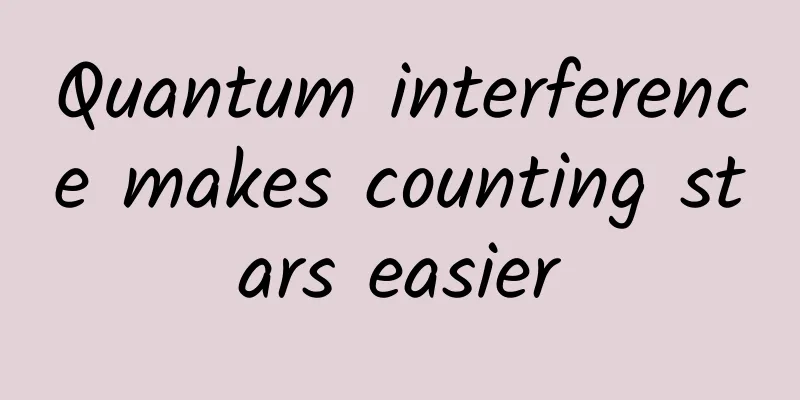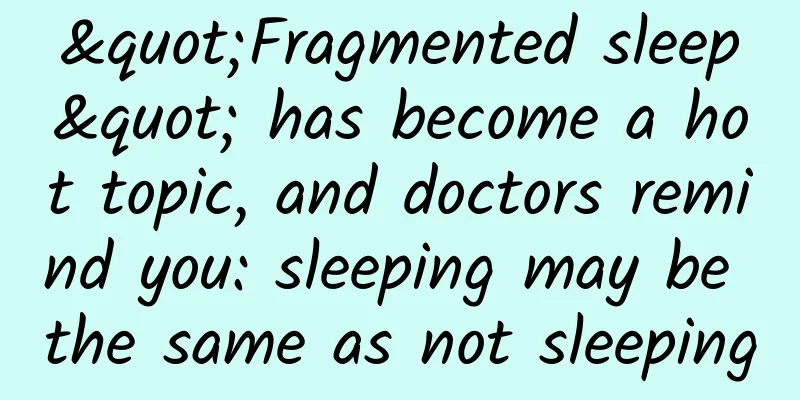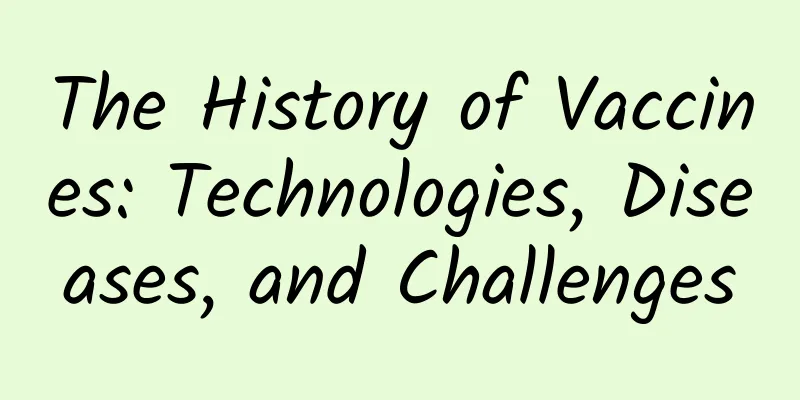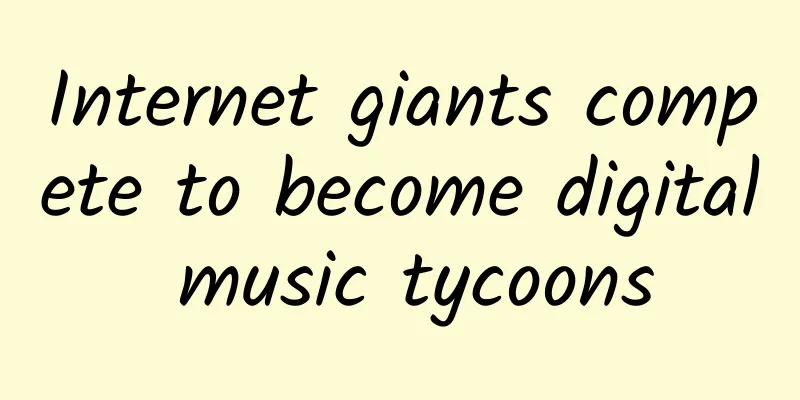Quantum interference makes counting stars easier

|
The exploration of the deep night sky has been with human civilization for thousands of years. The nursery rhyme "Twinkle, twinkle little star, the sky is full of little stars" has accompanied us as we grew up. Humans are always curious children in front of the vast universe, wanting to read the secrets of the universe for billions of years through the stars. Seventy years ago, radio astronomers pointed their telescopes at Sirius and a few other stars… There is a resolution limit for looking at stars When you hear about the telescopes used by astronomers, you must think they are very powerful. In fact, the telescopes used by astronomers are similar to our eyes in many ways. Each of us has had this experience: if you are on a plane, when you just take off and look at two lights close to each other on the ground, you can see them clearly. As you fly higher and higher, the two lights gradually merge into one and become difficult to distinguish. Moreover, the farther you are away, the closer the two lights are, and the harder it is to see them clearly. If you think of your eyes as an astronomical telescope and the two lights as distant stars, you will understand that the astronomical telescope also has its limitations, which is the resolution limit. The resolution limit refers to the limit of the distance between two adjacent objects that an optical instrument can distinguish. The reason for this limit is the diffraction of light. When a luminous body emits light, it is impossible for the light to really travel in a straight line in the geometric sense. There is always a certain divergence angle. As the light travels farther and farther, the light beam also diverges more and more. When it reaches the eye or telescope, it becomes a diffraction spot with a certain radius. Scientists call it "Airy disk". If two luminous bodies are relatively close to each other, the light beams hit the eye or telescope, and the Airy disks will overlap, making it difficult to distinguish between the two. Hanbury Brown - Twiss Interference The troubles caused by light have to be solved by the properties of light. 70 years ago, two radio astronomers, R. Hanbury Brown and RQ Twiss, who were looking up at the stars, thought of using the interference of light to break through the resolution limit brought by diffraction. We know that interference and diffraction are both properties of waves. For example, we can hear sounds behind obstacles, which is largely due to the diffraction of sound waves. In addition, wave interference is also very common. In a small pond in the drizzle, the water ripples stirred up by a few raindrops overlap and cross when they meet, forming a new ripple pattern - some places have stronger vibrations, and some places have weaker vibrations. This is the interference of water waves. Although light waves are not classical waves, we all know in high school that they also have similar diffraction and interference. Similar to the interference of classical waves, the interference fringes of light waves also have certain rules - where they are strengthened (brighter), where they are weakened (dimmer), the distance between light and dark fringes, etc., are determined by the following three variables: wavelength, the distance between the light source (star) and the film (telescope), and the distance between the two light sources (stars) each other. So, after reading this, you must have understood what to do, just like radio astronomers do, right? Fix the wavelength of light and the distance between the light source (star) and the film (telescope), and reverse the distance between the two light sources by observing the interference fringes of the two beams of light. Quantum waves and classical waves, combined but different Since you have also thought of this method, we can try its feasibility together. Light waves are quantum waves, which are significantly different from classical water waves and sound waves. How do light waves interfere with each other? To understand this, let's first learn about one of the most famous experiments in quantum mechanics - Young's double-slit interference experiment. Young's double-slit interference experiment is perhaps the most important experiment in quantum mechanics. The interference and superposition of probability waves are magically displayed in front of people through the "skill of clones" of electrons or photons. Many experiments in quantum mechanics that followed are essentially variations of Young's double-slit interference experiment. Since quantum waves are probability waves, describing the probability amplitude of a particle appearing at a certain position, the so-called observation of interference fringes is actually to see the count of the detected particles (electrons or photons) on the screen behind. The more counts, the brighter it is, and the fewer counts, the darker it is. When we discuss Young's double-slit interference experiment, many people will inadvertently overlook the most important and magical mechanism - that is, the first hole on the far left. In Young's double-slit interference experiment, it is this hole that ensures that the photons emitted from the two slits are of the same source - that is, they are exactly the same, so much so that even God cannot distinguish them. Otherwise, the interference pattern cannot be formed clearly. The same principle as Young's interference, the electron double-slit interference experiment also requires an electron to "simultaneously" pass through two slits to form interference fringes on the back screen. If two incoherent electron beams are emitted from two slits respectively, then on the back screen, only two bright fringes at the corresponding positions behind the two slits can be seen. Therefore, in order for the interference fringes of photons to be formed clearly, two conditions must be met - they arrive at the same time and cannot be distinguished. Arriving at the same time, this condition requires a signal matching technology, resulting in a greatly reduced number of events, but this can still be achieved by desperately accumulating data. But it is difficult to make photons indistinguishable. There is one most important basis for distinguishing different photons - frequency, but who can guarantee that the two objects to be observed are exactly the same color? Unless there is a technology that can change its frequency without changing the quantum properties of light. If it were 70 years ago, we would have been at a loss at this point. But now it is 2022. Quantum satellites have been launched into space, the Beijing-Shanghai trunk line has been built, and quantum computing superiority has been achieved. Quantum scientists may have a solution to the problem of interference of light of different frequencies. Crystal + waveguide, a fighter jet that converts frequency! In quantum communication schemes, optical fiber transmission and free space transmission each occupy half of the market. For optical fiber quantum communication, frequency conversion is a problem that must be faced. Because there are many situations in quantum communication where frequency conversion is needed. For example, the optical frequency used in quantum communication may not be exactly the band that the detector responds best to; the signal frequency in free space may be very lost in the optical fiber; in situations where quantum relays are required, the band that the repeater can store and transmit may not be able to connect to the optical fiber; sometimes, frequency conversion is even indispensable for free space quantum communication. For example, in order for quantum communication to be used during the day, it must be staggered with the frequency of sunlight. Therefore, frequency conversion is a specialty of scientists in the field of quantum communication. The reason why this can be achieved is actually due to the rise of nonlinear optics in the 1960s. In 1961, the second harmonic effect of ruby laser kicked off the drama of nonlinear optics. Since then, heroes from all walks of life have taken turns to fight, and various nonlinear optical technologies and materials have emerged. Among them, a material called lithium niobate has been widely used. Lithium niobate is a negative uniaxial crystal with birefringence effect. It is also a ferroelectric with large spontaneous polarization intensity and nonlinear coefficient. The essence of nonlinear optical process is the interaction between light and matter. The sum frequency, frequency doubling and difference frequency processes we often use are all nonlinear conversion processes. In this process, the signal light gradually decreases and is converted into the sum frequency light, frequency doubling light and difference frequency light we need. The core of frequency conversion using nonlinear crystals is quasi-phase matching, that is, momentum conservation, which results in high conversion efficiency. Usually, if periodic nonlinear crystals are used, the frequency conversion efficiency can even be close to 1 if the parameters are appropriate. If lithium niobate is an extremely excellent nonlinear material, then its combination with waveguides is a perfect match. Scientists periodically polarize lithium niobate crystals and then form an optical waveguide structure in the crystal. Using this method, they have formed the best frequency conversion device - periodically polarized lithium niobate waveguides. The waveguide helps it achieve friendly docking with the optical fiber and well constrains the light beam. With the help of waveguides, the conversion efficiency of periodically polarized lithium niobate crystals is greatly improved. With the secret weapon of periodically polarized lithium niobate waveguides, single-photon detectors can show their prowess in the field of quantum communications. Try it out Now that they have a good weapon, scientists are ready to try whether this frequency conversion method can be effective in the Hanbury Brown-Twiss interferometry method. In the experiment, the periodically polarized lithium niobate waveguide specially designed by scientists is like a magician's mysterious box. When a 1550nm photon enters, there is a 50% probability of it being transformed into an 863nm photon, and the other 50% probability of it remaining unchanged; similarly, there is a 50% probability of a 863nm photon being transformed into a 1550nm photon, and the other 50% probability of it remaining unchanged. In this way, when the detector sees a photon, it has no way of distinguishing whether this frequency is its original appearance or has undergone a clever transformation. Therefore, after such a mutual conversion, the photons become indistinguishable to the detector. The results did not disappoint. In 2019, Pan Jianwei, Zhang Qiang and others from the University of Science and Technology of China collaborated with Frank Wilczek from the Massachusetts Institute of Technology to build a two-color intensity interference experimental system using a color-independent detector. They achieved intensity interference of 1550nm and 863nm light sources and verified it in coherent light sources, thermal light sources and space experiments. The results were in line with expectations. The experimental results show that after the nonlinear device is turned on, the interference fringes appear clearly (the red curve in Figure c), while when the nonlinear device is not turned on, the interference fringes are not visible (the blue curve in Figure c). The relevant results were published in Physical Review Letters [1]. Step out of the room and beyond the wavelength barrier After completing the verification in the laboratory, scientists want to go out of the house and verify how this interference technology works in the free space outdoors. More importantly, scientists hope to solve a more important problem - not to have such strict restrictions on wavelength. According to the previous technical methods, we can find that there are great restrictions on the wavelength of the light source to be observed, and the frequencies of the two photons to be measured cannot be too close. This is determined by the technical route of "nonlinear crystal + waveguide". Photons use nonlinear crystals to achieve frequency conversion, often through a sum-frequency (or difference-frequency) process (Sum-frequency Generation, SFG). The reason why it is called a sum-frequency process is that we can simply think of it as: a signal light with a frequency of ω1, under the blessing of a pump light with a frequency of ω2, passes through a nonlinear crystal to obtain a sum-frequency light with a frequency of ω3 (=ω1+ω2). (If it is a difference-frequency process, then ω3=ω1-ω2, and the reason is similar.) It can be imagined that if, as before, light sources with large wavelengths (frequencies) such as 1550nm and 863nm are converted to each other, it is still easy to find a suitable pump light; and if the ω1 of the signal light is very close to the ω3 of the sum-frequency light, it means that the frequency ω2 of the pump light is very small. At this time, the waveguide suitable for ω1 and ω3 may not be very suitable for ω2, and a technical limitation is encountered. In order to solve the problem, scientists abandoned the idea of mutual conversion of ω1 and ω3 light, and let ω1 and ω3 light each go through a nonlinear process and be converted into photons of the same frequency for interference. In this way, the two can find appropriate pump light to match, which perfectly solves the problem of observation wavelength limitation and greatly broadens the application scope of color erasure interference method. In addition, scientists have also broken through the previous limitations of space and stepped out of the laboratory to try to see if they can observe two light sources that are far away and very close to each other in free space. Phase - the spatially resolved messenger In addition to breaking through the limitations of indoor space and wavelength, this upgraded version also has another challenge: scientists want to see the full picture of photons - that is, to spatially resolve the target by detecting and analyzing the phase information of photons. When it comes to phase information, you may often overlook its importance. For example, on a flat photo, how does our brain judge the distance of an object? It is nothing more than making logical judgments based on information such as occlusion and size. For example, if person A blocks person B, we think A is in front and B is behind; if the same tree, A is larger and B is smaller, we think A is near and B is far. Without this information, it is not easy for us to accurately judge the distance. But holographic photos are not like this. Holographic photos not only record the frequency and intensity information of light, but also the phase information of light. That is to say, when the light reaches your eyes, it tells you where it came from. Therefore, the image of the object is displayed in three dimensions in front of us, just like the real objects we usually see. Therefore, adding the phase information is not a waste of the photons that have come from afar. In this upgraded version of the color erasure interference experiment, scientists focused on the phase. As shown in the figure below, in this experimental design, S1 and S2 are two distant light sources that are very close to each other, and TA and TB are two telescopes used for observation. The phase information between the light source and the telescope will affect the degree of coherence at each position on the line connecting the two telescopes. The experimenters observed the interference at each position on this line. After measurement, analysis, and calculation, using the phase information as a medium, they can obtain the angular distance of the light source, that is, the ratio of the distance d between the two light sources to the distance x between the two telescopes. In actual experiments, Pan Jianwei, Zhang Qiang and others from the University of Science and Technology of China collaborated with Frank Wilczek from the Massachusetts Institute of Technology to build a color-erasing intensity interferometer using a periodically polarized lithium niobate waveguide developed by the Jinan Institute of Quantum Technology. They successfully distinguished two light sources 1.43 kilometers away, 4.2 millimeters apart, with wavelengths of 1063.6 and 1064.4 nanometers, respectively, which exceeded the diffraction limit of a single telescope by about 40 times. Not only did they break through the wavelength limitation, but they also obtained the Fourier transform phase information of the imaged object. The relevant results were recently published in Physical Review Letters [2]. The realization of this technology is not only to finally realize the plan of two astronomers, Hanbury Brown and Twiss, so that people can finally see two stars of different colors at close distances, but also to expand the limits of optical observation. You know, it is not only astronomers who want to see the "stars" clearly. For many biologists, small fluorescent molecules are the "brightest stars" in their eyes, but it is often a headache to see them because they are too small and too close. With this color-independent intensity interference detection technology, biologists can also distinguish two fluorescent molecules of different colors. In the future, scientists will continue to reduce the phase noise within the system to make the system more accurate and sensitive. If combined with future high-precision time and frequency transmission technology and telescope arrays, the application scenarios will be greatly expanded. Whether it is observing cosmic stars, space debris, or biological molecules, it will demonstrate its uniqueness and irreplaceability. Paper link: [1] https://journals.aps.org/prl/abstract/10.1103/PhysRevLett.123.243601 [2] https://link.aps.org/doi/10.1103/PhysRevLett.127.103601 Source: Mozi Salon The Mozi Salon is a large-scale public science forum named after the Chinese sage "Mozi". It is hosted by the Shanghai Research Institute of the University of Science and Technology of China, and co-organized by the USTC New Alumni Foundation, the USTC Education Foundation, the Pudong New Area Science and Technology Association, the China Association for Science and Technology, and the Pudong New Area Science and Technology and Economic Committee. Mozi is a famous thinker and scientist in ancient my country. His thoughts and achievements are the embodiment of the early scientific buds in my country. The establishment of the "Mozi Salon" aims to inherit and carry forward the scientific tradition, build a social atmosphere that respects science, improve citizens' scientific literacy, and advocate and promote the scientific spirit. The target of science popularization is the general public who love science, have a spirit of exploration and curiosity. We hope to enable the public with the equivalent of middle school or above to understand and appreciate the world's most cutting-edge scientific progress and scientific ideas. |
<<: There are various optical illusions. What is the point of studying them?
>>: Large-scale "encounter" with Omicron - Focus on the six major focuses of the Tianjin epidemic
Recommend
Perfect Diary’s Brand Positioning Practice
Some people believe that the positioning theory, ...
vivo Global Mall: Universal pickup code design for e-commerce platforms
Author|vivo official website mall development tea...
Perfect Diary’s secret to live streaming on Tik Tok!
Tik Tok has always been an important platform for...
Xiao Weiqing: English Original Reading Basic Class | Shanghai International Studies University professor leads the reading of The Chronicles of Narnia
Xiao Weiqing: English Original Reading Basic Clas...
The romantic rise and fall of WeChat public accounts
[[247951]] Prequel On July 21, 2012, Beijing, whi...
Why do users convert?
Before you start reading this article, please thi...
South Korea's OLED industry is influenced by Japan's vapor deposition machines. Who will be the ultimate winner?
Samsung and LG of South Korea are actively reduci...
Badou College AI Practical Tutorial-Courses Specialized for Employment 2021
Badou College AI Practical Tutorial-Courses Speci...
First appearance! The kneeling figure and bronze beast of Sanxingdui are combined
On January 1, the Sichuan Provincial Institute of...
China Automobile Dealers Association: China Automobile Consumer Reputation Index in December 2021
On January 6, 2022, the China Automobile After-sa...
The growth caused by one sentence of copywriting and the logical code behind it
Sometimes a piece of copy can achieve unexpected ...
Short video promotion tips for Huoshan, Kuaishou, Douyin, etc.!
Traffic is the focus of everyone's attention ...
How much does it cost for Dehong to join a lottery app?
What is the price for joining the Dehong Lottery ...
Why are Silicon Valley CEOs obsessed with artificial intelligence?
[[161924]] Jarvis, the artificial intelligence bu...
How much benefit can Second Brother bring to mankind by transplanting a pig's heart into a living human body?
Key Points ★ Every year, less than 10% of those i...









![[Scholars from the Saiwai] 20220514 Dragon Control Secrets (I) Resonance Dragon: Revealing the common secrets of Jiantou, Tianbao and Jianyi + Predicting the midday trading next week](/upload/images/67cc01a44f63e.webp)